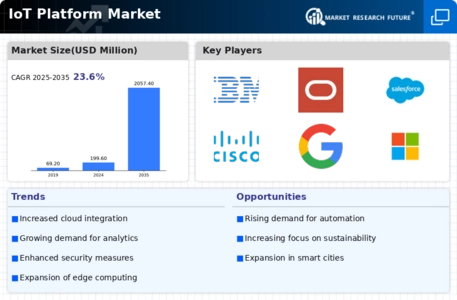Market Trends
Key Emerging Trends in the IOT Platform Market
The Internet of Things (IoT) platform market has witnessed remarkable growth in recent years, driven by the widespread adoption of connected devices across various industries. One notable trend in the IoT platform market is the increasing demand for edge computing capabilities. As the number of connected devices continues to rise, the need for processing data closer to the source, or at the edge, becomes crucial for reducing latency and improving real-time decision-making. Edge computing in IoT platforms allows for more efficient data processing, enabling quicker response times and enhanced overall system performance.
Furthermore, interoperability has emerged as a key trend in the IoT platform market. As the IoT ecosystem expands, there is a growing need for seamless communication and integration among diverse devices and platforms. Interoperable IoT platforms enable different devices and applications to work together, fostering a more connected and cohesive IoT environment. This trend is particularly significant in industries such as smart homes, healthcare, and industrial automation, where various devices must collaborate to deliver comprehensive solutions.
Security is another critical trend shaping the IoT platform market. With the increasing number of connected devices, there is a heightened awareness of the potential vulnerabilities in IoT networks. As a result, there is a growing emphasis on implementing robust security measures in IoT platforms to protect sensitive data and ensure the integrity of connected devices. Security features such as encryption, authentication, and secure device management are becoming integral components of IoT platforms to address the evolving threat landscape.
The integration of Artificial Intelligence (AI) and Machine Learning (ML) into IoT platforms is gaining momentum. These technologies enhance the capabilities of IoT platforms by enabling intelligent data analysis and predictive insights. AI and ML algorithms can process large volumes of data generated by IoT devices, extract meaningful patterns, and provide valuable insights for better decision-making. This integration is particularly relevant in applications such as predictive maintenance, anomaly detection, and optimization of operational processes.
A notable shift towards hybrid IoT platforms is evident in the market. Hybrid platforms offer a combination of cloud-based and on-premises solutions, providing flexibility in deployment options. This trend caters to organizations with specific regulatory or data residency requirements, allowing them to choose a deployment model that aligns with their preferences and compliance needs. The hybrid approach also addresses concerns related to latency and connectivity by offering a balance between centralized cloud processing and localized edge computing.
In terms of market players, partnerships and collaborations are on the rise. IoT platform providers are forming strategic alliances with hardware manufacturers, software developers, and service providers to create comprehensive and integrated IoT solutions. These partnerships aim to address end-to-end IoT requirements, from device connectivity to data analytics, and to deliver a seamless user experience. Such collaborations contribute to the development of holistic IoT ecosystems that can cater to diverse industry needs.
The focus on sustainability is becoming increasingly prominent in the IoT platform market. As the environmental impact of technology gains attention, there is a growing interest in developing and adopting IoT solutions that contribute to sustainability goals. IoT platforms are being leveraged to monitor and optimize energy consumption, reduce waste, and enhance resource efficiency across various sectors, including smart cities, agriculture, and manufacturing.

















Leave a Comment